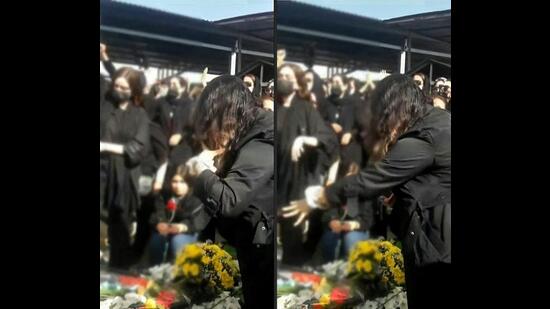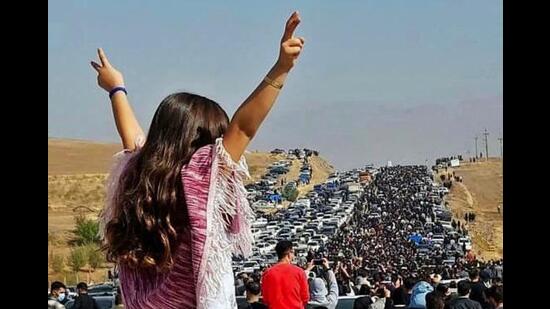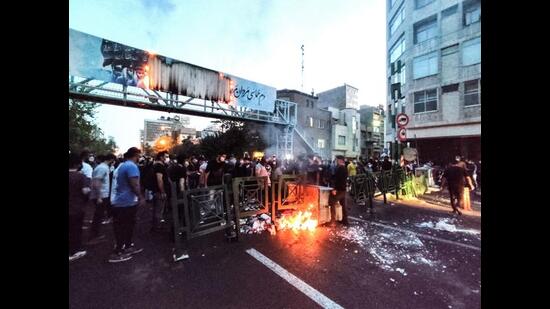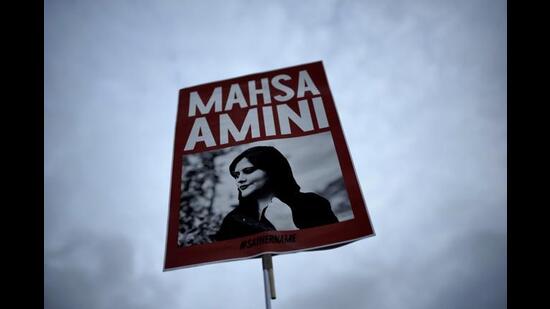Frida and Frankenstein: Fetishisation of the Iranian Revolution
Frida Kahlo with a disinterested expression holds a scissor, her braid and locks of hair scattered around. Added to the Self-portrait with Cropped Hair are the words of a Mexican song: “Look, if I loved you it was because of your hair. Now that you are without hair, I don’t love you anymore.” Critics of the time had said that it was an assertion of her identity after her divorce.
I have been thinking about the painting because young Iranian women who are taking off the hijab are being sent flowers with notes that read, “Thank you for making the city more beautiful with your free hair.”
***
In an acknowledgment of their determination, Time magazine has named the women of the Iranian Revolution as the heroes of 2022, referring to the protests following the custodial death of Mahsa Amini on September 16 as “the most sustained uprising in the 43-year history of the Islamic Republic”.
This is not true. The 2009 reformist Green Movement lasted for 20 months. “Don’t be afraid. We are together” became the anthem. The July 1999 student protests had slogans like “Death to autocracy, death to monopolists” and “We will kill those who kill the brothers”. These were brave rebellions against the clergy, the government, and social and economic policies. The only Iranian Nobel laureate is a woman. Lawyer, activist and writer Shirin Ebadi won the Nobel Peace Prize for her efforts in fighting for human rights, that included representing dissenters. She was even arrested for implicating government officials for the murder of students.
In his book Democracy in Iran: Why It Failed and How It Might Succeed, sociologist Misagh Parsa wrote about how the overthrow of monarchy in 1979 was itself “one of the great revolutions in the modern world. Iran’s intellectuals, students, merchants, and working and middle classes engaged in large-scale collective action and demanded political freedom, independence from Western powers”.
Historian Ervand Abrahamian believed that while 19th century European revolutions often started in opera houses, the Iranian Revolution to overthrow the Shah could have begun in poetry-reading sessions. Large crowds attended the dah shab, the 10 nights of literature reading sessions.
How did the clergy that promised, “In Islamic society women will be free to choose their own destiny and own activity. God created us equal” transform into one that inspired aggression and public physical attacks against women? Why did those women not become the fulcrum of any revolution that the world would notice?
The female body and what clothes it are the battlefield on which gender justice is fought and, thereby, reduced to. In 2013, expat female Iranian activists who didn’t even wear a veil staged a topless demonstration in Sweden, their bodies painted with the slogans, “Nudity is my protest” and “No to hijab”. In 2017, a young woman held a headscarf on a stick in a place called Revolution Street in Iran. These have more appeal for the outsider than an acid attack survivor.
Women have been helming the present protests to revolt against the mandatory hijab. It is also the main reason for the West to recognise the uprising as legitimate, for it is in the streets of America and Europe that people have pulled off the headscarves of women.

The objectification manifests itself in the literary and cultural images used to convey empathy too.
Street artist AleXsandro Palombo created a mural opposite the Iran Consulate in Milan that showed Marge Simpson (of the animation sitcom The Simpsons) with her hair cut in solidarity. Her iconic blue beehive hairstyle was inspired by the Bride of Frankenstein, based on the novel by Mary Shelley.
If the idea was to oppose a head covering, then why snip off the hair instead of flaunting it? Unless the artist was merely using a character from a banned sitcom to mock at Iran’s policy where even cartoon characters have to be veiled. Yet, art for a cause in this case emphasises the literal, ignoring the deeper meaning of the allusion for Frankenstein had to create a woman for the Monster but left her unfinished as he imagined she would breed a “race of devils”. The Monster seeks vengeance by killing Frankenstein’s wife. The women have no agency, primarily being “beautiful but repugnant” in varying degrees.

In the three months since the revolt began, according to official figures around 400 Iranian protesters have been killed by security forces. The Time cover piece on their heroism was a prime example of patronising empathy: the “movement they’re leading is educated, liberal…and (the young women are) desperate for normality: college and foreign travel… access to the Apple Store… they are vegans, they de-Islamicize their names, they don’t want children”. Worse, being on Snapchat they “can peer into the lives of their cousins around the world, acutely aware they’re the only ones who have to wear a school uniform that includes a hooded headscarf, as though they are Benedictine nuns.”
Such is the imposition of reductionism on revolutions.
***
The women wanting to throw away their headscarf have every right to do so and must be lauded for their courage; women wearing veils are also in the streets protesting alongside them. So why should it be assumed that they view the western standard and perspective as the norm?
“Hey Ayatollah, Leave Those Kids Alone!” is back in the news. 15 years ago, two Iranian-born brothers from the band Blurred Vision altered the lyrics of the Pink Floyd number “Another Brick in the Wall”, questioning the religious guardianship of Ayatollah Khamenei.
The wars within should resist getting co-opted. Why use a western song when the protests are indigenous? This ends up as another form of “thought control”.

Ironically, with its fascination for the petite European nose, Iran became the rhinoplasty capital only after the clergy took over. “God is beautiful and loves beauty.” Quoting from a Hadith, Ayatollah Khomeini had sanctioned nose jobs for women back in the 1980s. According to an article in The Vice, “There’s no question that Iranian culture influences the behaviour of the people more than Islam does, and for centuries that culture has placed a deep focus on physical beauty in all its forms. Given that, one explanation seems to have caught on: Because the mandatory hijab leaves nothing but the small circle of the face as a canvas for beauty and self-expression, Iranian women have become obsessed with their faces.”
The world became obsessed with the face of 26-year-old Neda Agha-Soltan, an onlooker who was shot dead as she stood silently witnessing the protests of 2009 in Tehran. Her death was captured on video, her bloodied body, and her eyes, becoming “probably the most widely witnessed death in human history”. In an interview months later after she had found the courage to watch it, Neda’s mother Hajar Rostami-Motlagh observed, “I felt so sick; I can’t describe it. Neda’s open eyes drove me mad. When someone dies, her eyes close, but my Neda’s eyes remained open. I am certain that they won’t close until she achieves her goal… Neda’s open eyes, the blood she coughed up, her last moments and her cry of ‘I’m burning’ are constantly with me. They destroy me from the inside. Neda’s eyes disturb me a lot. Her eyes were searching for the ‘why’ of her life and the ‘why’ of her death.”
During the 1979 insurgency, a line from the 14th-century Persian poet Hafez became a slogan: “Div cho birun ravad fereshteh dar ayad” (When the demon departs, the angel shall arrive). The seraph has transformed into the demon today, but there are no angels in sight. Contemporary revolutions must contend with being collective catharsis over martyred young lives.
Farzana Versey is a Mumbai-based writer. She tweets at @farzana_versey
This winter season, get Flat 20% Off on Annual Subscription Plans
Enjoy Unlimited Digital Access with HT Premium

Frida Kahlo with a disinterested expression holds a scissor, her braid and locks of hair scattered around. Added to the Self-portrait with Cropped Hair are the words of a Mexican song: “Look, if I loved you it was because of your hair. Now that you are without hair, I don’t love you anymore.” Critics of the time had said that it was an assertion of her identity after her divorce.
I have been thinking about the painting because young Iranian women who are taking off the hijab are being sent flowers with notes that read, “Thank you for making the city more beautiful with your free hair.”
***
In an acknowledgment of their determination, Time magazine has named the women of the Iranian Revolution as the heroes of 2022, referring to the protests following the custodial death of Mahsa Amini on September 16 as “the most sustained uprising in the 43-year history of the Islamic Republic”.

This is not true. The 2009 reformist Green Movement lasted for 20 months. “Don’t be afraid. We are together” became the anthem. The July 1999 student protests had slogans like “Death to autocracy, death to monopolists” and “We will kill those who kill the brothers”. These were brave rebellions against the clergy, the government, and social and economic policies. The only Iranian Nobel laureate is a woman. Lawyer, activist and writer Shirin Ebadi won the Nobel Peace Prize for her efforts in fighting for human rights, that included representing dissenters. She was even arrested for implicating government officials for the murder of students.
In his book Democracy in Iran: Why It Failed and How It Might Succeed, sociologist Misagh Parsa wrote about how the overthrow of monarchy in 1979 was itself “one of the great revolutions in the modern world. Iran’s intellectuals, students, merchants, and working and middle classes engaged in large-scale collective action and demanded political freedom, independence from Western powers”.
Historian Ervand Abrahamian believed that while 19th century European revolutions often started in opera houses, the Iranian Revolution to overthrow the Shah could have begun in poetry-reading sessions. Large crowds attended the dah shab, the 10 nights of literature reading sessions.
How did the clergy that promised, “In Islamic society women will be free to choose their own destiny and own activity. God created us equal” transform into one that inspired aggression and public physical attacks against women? Why did those women not become the fulcrum of any revolution that the world would notice?
The female body and what clothes it are the battlefield on which gender justice is fought and, thereby, reduced to. In 2013, expat female Iranian activists who didn’t even wear a veil staged a topless demonstration in Sweden, their bodies painted with the slogans, “Nudity is my protest” and “No to hijab”. In 2017, a young woman held a headscarf on a stick in a place called Revolution Street in Iran. These have more appeal for the outsider than an acid attack survivor.
Women have been helming the present protests to revolt against the mandatory hijab. It is also the main reason for the West to recognise the uprising as legitimate, for it is in the streets of America and Europe that people have pulled off the headscarves of women.

The objectification manifests itself in the literary and cultural images used to convey empathy too.
Street artist AleXsandro Palombo created a mural opposite the Iran Consulate in Milan that showed Marge Simpson (of the animation sitcom The Simpsons) with her hair cut in solidarity. Her iconic blue beehive hairstyle was inspired by the Bride of Frankenstein, based on the novel by Mary Shelley.
If the idea was to oppose a head covering, then why snip off the hair instead of flaunting it? Unless the artist was merely using a character from a banned sitcom to mock at Iran’s policy where even cartoon characters have to be veiled. Yet, art for a cause in this case emphasises the literal, ignoring the deeper meaning of the allusion for Frankenstein had to create a woman for the Monster but left her unfinished as he imagined she would breed a “race of devils”. The Monster seeks vengeance by killing Frankenstein’s wife. The women have no agency, primarily being “beautiful but repugnant” in varying degrees.

In the three months since the revolt began, according to official figures around 400 Iranian protesters have been killed by security forces. The Time cover piece on their heroism was a prime example of patronising empathy: the “movement they’re leading is educated, liberal…and (the young women are) desperate for normality: college and foreign travel… access to the Apple Store… they are vegans, they de-Islamicize their names, they don’t want children”. Worse, being on Snapchat they “can peer into the lives of their cousins around the world, acutely aware they’re the only ones who have to wear a school uniform that includes a hooded headscarf, as though they are Benedictine nuns.”
Such is the imposition of reductionism on revolutions.
***
The women wanting to throw away their headscarf have every right to do so and must be lauded for their courage; women wearing veils are also in the streets protesting alongside them. So why should it be assumed that they view the western standard and perspective as the norm?
“Hey Ayatollah, Leave Those Kids Alone!” is back in the news. 15 years ago, two Iranian-born brothers from the band Blurred Vision altered the lyrics of the Pink Floyd number “Another Brick in the Wall”, questioning the religious guardianship of Ayatollah Khamenei.
The wars within should resist getting co-opted. Why use a western song when the protests are indigenous? This ends up as another form of “thought control”.

Ironically, with its fascination for the petite European nose, Iran became the rhinoplasty capital only after the clergy took over. “God is beautiful and loves beauty.” Quoting from a Hadith, Ayatollah Khomeini had sanctioned nose jobs for women back in the 1980s. According to an article in The Vice, “There’s no question that Iranian culture influences the behaviour of the people more than Islam does, and for centuries that culture has placed a deep focus on physical beauty in all its forms. Given that, one explanation seems to have caught on: Because the mandatory hijab leaves nothing but the small circle of the face as a canvas for beauty and self-expression, Iranian women have become obsessed with their faces.”
The world became obsessed with the face of 26-year-old Neda Agha-Soltan, an onlooker who was shot dead as she stood silently witnessing the protests of 2009 in Tehran. Her death was captured on video, her bloodied body, and her eyes, becoming “probably the most widely witnessed death in human history”. In an interview months later after she had found the courage to watch it, Neda’s mother Hajar Rostami-Motlagh observed, “I felt so sick; I can’t describe it. Neda’s open eyes drove me mad. When someone dies, her eyes close, but my Neda’s eyes remained open. I am certain that they won’t close until she achieves her goal… Neda’s open eyes, the blood she coughed up, her last moments and her cry of ‘I’m burning’ are constantly with me. They destroy me from the inside. Neda’s eyes disturb me a lot. Her eyes were searching for the ‘why’ of her life and the ‘why’ of her death.”
During the 1979 insurgency, a line from the 14th-century Persian poet Hafez became a slogan: “Div cho birun ravad fereshteh dar ayad” (When the demon departs, the angel shall arrive). The seraph has transformed into the demon today, but there are no angels in sight. Contemporary revolutions must contend with being collective catharsis over martyred young lives.
Farzana Versey is a Mumbai-based writer. She tweets at @farzana_versey
This winter season, get Flat 20% Off on Annual Subscription Plans
Enjoy Unlimited Digital Access with HT Premium

